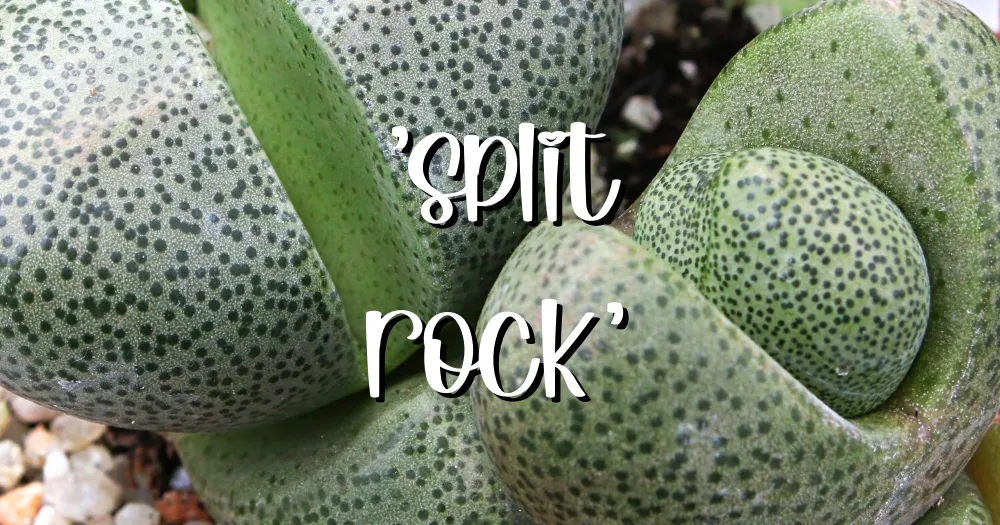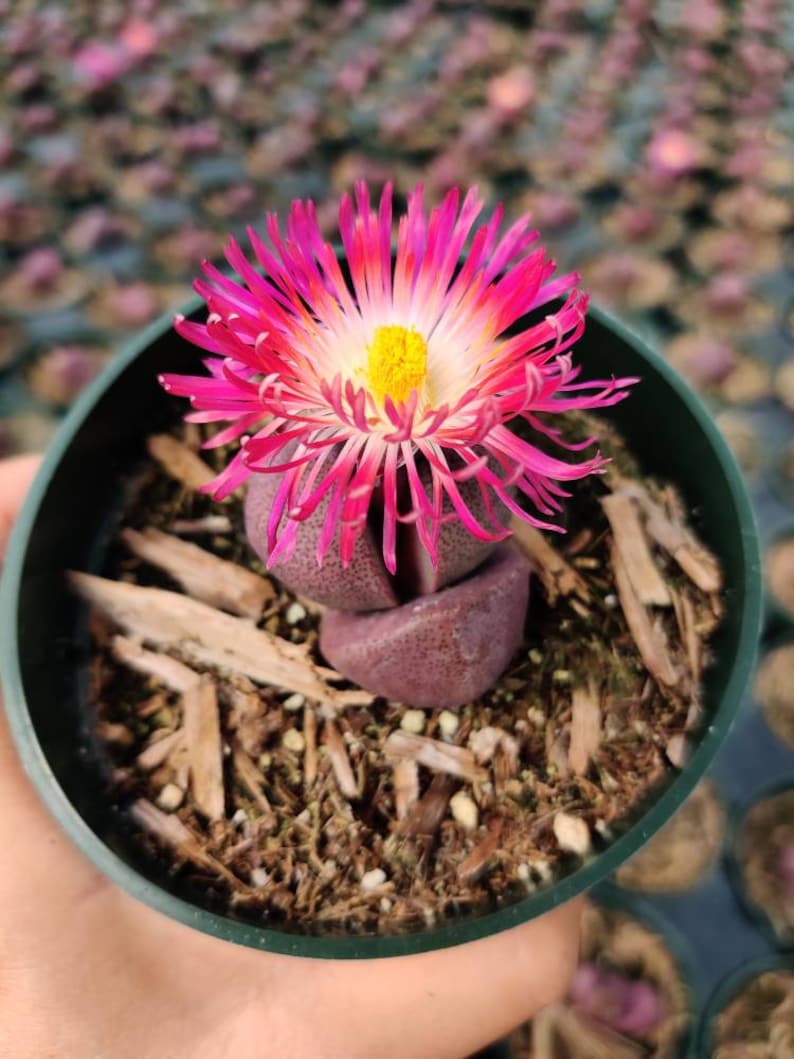The ‘Split Rock’ succulent, also known as Pleiospilos nelii, is a unique plant that has a striking resemblance to a small boulder with deep crevices. Its leaves have a rough texture and grow in pairs, forming a fissure in the center that looks like a slit. This succulent is fascinating to observe and is sure to be a great addition to any succulent collection.
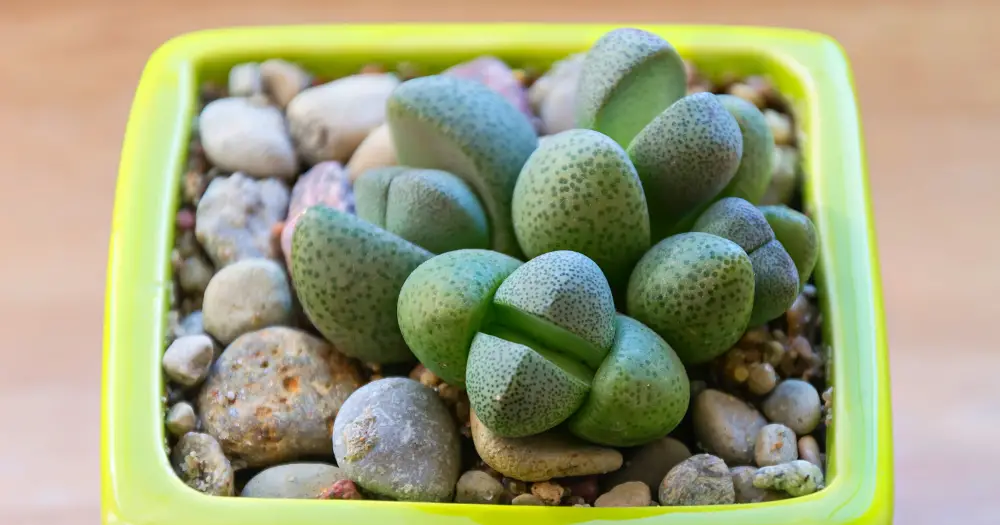
Native Habitat
Pleiospilos nelii ‘Split Rock’ succulent is native to the arid regions of South Africa, where it is found growing in rocky areas with very little soil. It is well-suited to thrive in these harsh environments, where it has adapted to the dry conditions by storing water in its fleshy leaves. Its ability to store water makes it an excellent drought-resistant plant and allows it to survive long periods of water scarcity.
You might also like: Native Habitats of Succulents: Explore the Incredibly Diverse Environments

Source: Etsy
In its native habitat, Pleiospilos nelii ‘Split Rock’ succulent grows in areas with high temperatures and receives plenty of sunlight. It is commonly found in the Northern and Western Cape provinces of South Africa, where it grows in gravelly and rocky terrain. The plant’s ability to grow in such conditions is due to its remarkable adaptation to the lack of soil and water. Its root system is shallow and wide, allowing it to absorb moisture quickly, while its leaves are thick and fleshy, enabling them to store water for longer periods.
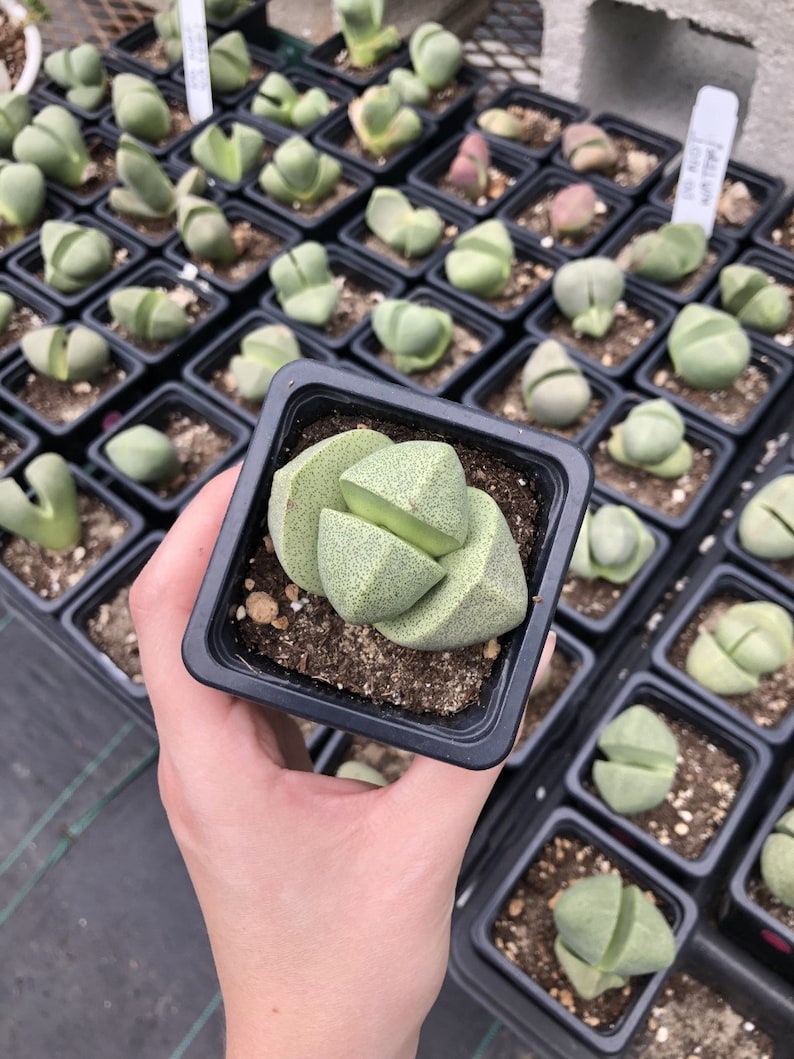
Source: Etsy
You might also like: Summer Succulent Care: Keep Your Plants Happy During the Warm Months
Pleiospilos nelii ‘Split Rock’ succulent is also known for its tolerance to extreme temperatures, including cold winters and hot summers. Its hardiness in these conditions is due to its adaptation to the rocky terrain and its ability to conserve water during dry spells. With the right conditions and care, the ‘Split Rock’ succulent can grow beautifully and thrive in a range of environments.
You might also like: Caring for Succulents While on Vacation (Hopefully to an Amazing Place) 2023
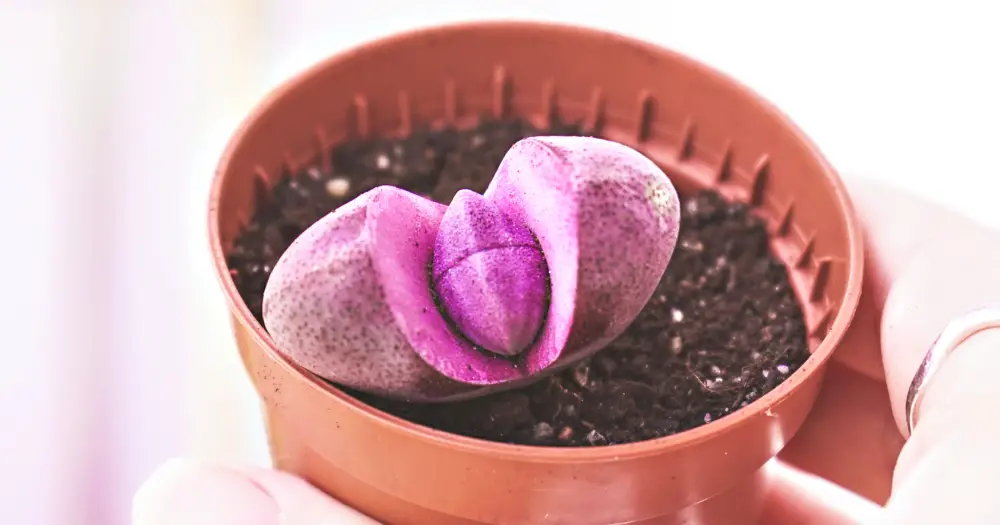
When to Water ‘Split Rock’
Proper watering and fertilizing are essential for the health and growth of Pleiospilos nelii ‘Split Rock’. This succulent requires low watering requirements and needs to be watered only when the soil is completely dry. Overwatering can cause the roots to rot, so it is important to avoid watering the fissure or crown of the plant. Instead, water the soil around the base of the plant and let it soak in. Watering should be reduced during the winter months as the plant goes dormant.
You might also like: Succulent Fertilizer: The Ultimate Guide to Healthy Succulents + 8 DIY Fertilizer Recipes
Fertilizing Pleiospilos nelii ‘Split Rock’ should be done once a month during the growing season (spring and summer). A balanced liquid fertilizer at half strength is recommended. It is important not to over-fertilize as this can lead to burning of the leaves or root damage. Fertilizing the succulent during its dormant period is not recommended as it is not actively growing and does not require extra nutrients. With proper watering and fertilizing, the ‘Split Rock’ succulent can grow healthy and beautiful.
You might also like: 5 Reasons to Avoid Misting Succulents: The Surprising Consequences of Misting

Succulent fertilizer available to purchase on Etsy.
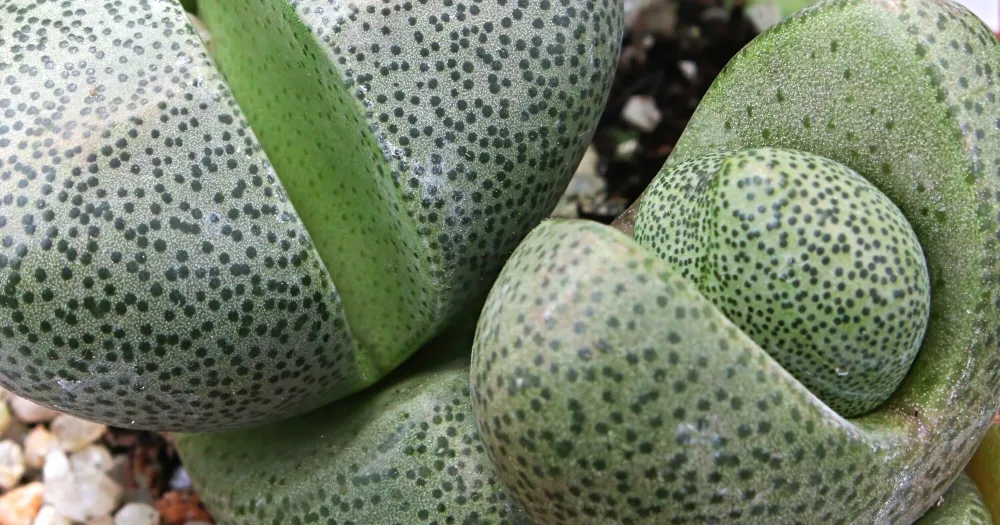
Soil
Pleiospilos nelii ‘Split Rock’ requires well-draining soil to grow healthily. The ideal soil mixture for this succulent should consist of a blend of Turface, pumice, perlite, and coarse sand. This mixture is excellent for providing the plant with the necessary drainage to prevent the roots from sitting in water, which can lead to rot and fungal infections.
You might also like: Succulent Soil: Ultimate Guide & 4 DIY Recipes to Keep Your Succulents Happy and Healthy
Turface is a soil amendment made of high-fired calcined clay, which is an excellent water-absorbing material. It also helps the soil retain nutrients, making it an excellent addition to the soil mixture for ‘Split Rock’ succulent. Pumice is a volcanic rock that is lightweight and porous, allowing it to absorb water and improve the drainage of the soil. It also provides a stable structure for the roots to anchor, ensuring healthy growth.
You might also like: Rocks On Top of the Soil
Perlite is another popular soil amendment that is made by heating volcanic glass to high temperatures, causing it to expand and become lightweight. It provides excellent drainage and aeration to the soil, making it ideal for succulent plants. Coarse sand, on the other hand, provides structure to the soil and prevents compaction, ensuring that the soil remains loose and airy.
You might also like: Repotting Succulents: The Best Time to Repot Your Plants and 3 Ways to Tell When It’s Time
When planting your ‘Split Rock’ succulents, it is essential to use this soil mixture to ensure that the plant grows healthy and thrives. The mixture allows the soil to drain well while also providing the necessary nutrients to the roots. It is also recommended to use a pot with drainage holes to allow excess water to drain out, preventing waterlogging and root rot.
You might also like: Drainage Hole at the Bottom of The Pot: Do Succulents Need Them? The Answer Might Completely Shock You!
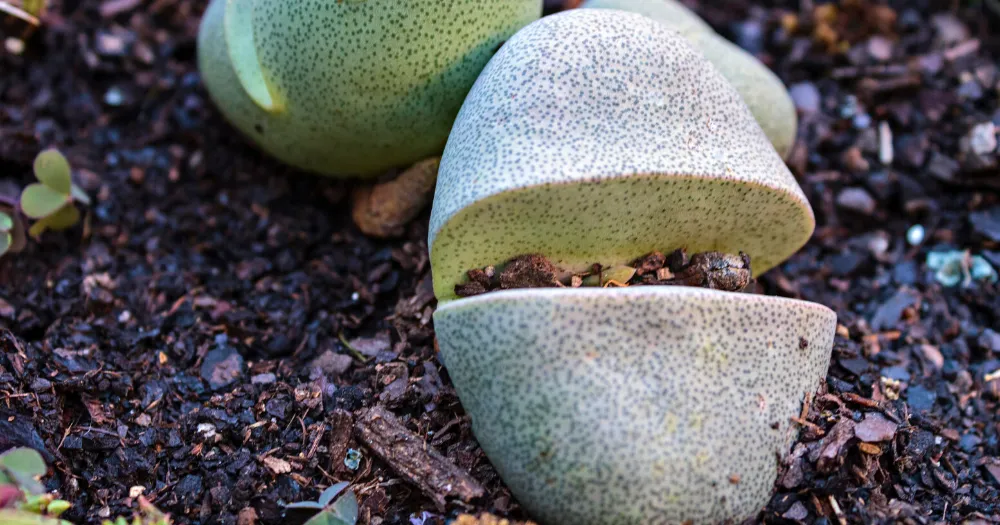
How to Propagate ‘Split Rock’
Propagation of Pleiospilos nelii ‘Split Rock’ can be done by seed or by division. When propagating by seed, it is best to sow them in early spring. Division should be done in early summer, taking care not to damage the roots.
You might also like: Propagating Succulents 4 Ways: The Best Guide Ever

Light
Pleiospilos nelii ‘Split Rock’ prefers bright, indirect light and can be placed on a sunny windowsill or outdoors in a partially shaded area. The split or cleft leaves are more pronounced with increased light levels. If your plant does not show distinctive split leaves, it probably needs brighter light to support this morphology.
You might also like: How Much Light Do Succulents Need? A Comprehensive Guide in 12 Parts
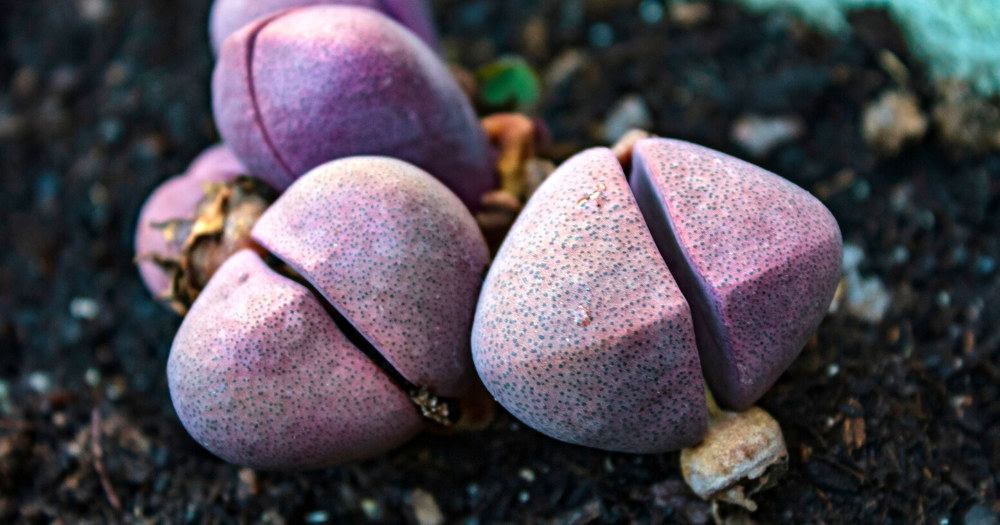
Hardiness Zone & Temperature
‘Split Rock’ thrives in warm temperatures and is hardy in USDA zones 9 to 11. The ideal temperature range is between 65 to 80 degrees Fahrenheit.
You might also like: Succulent Care by Zones
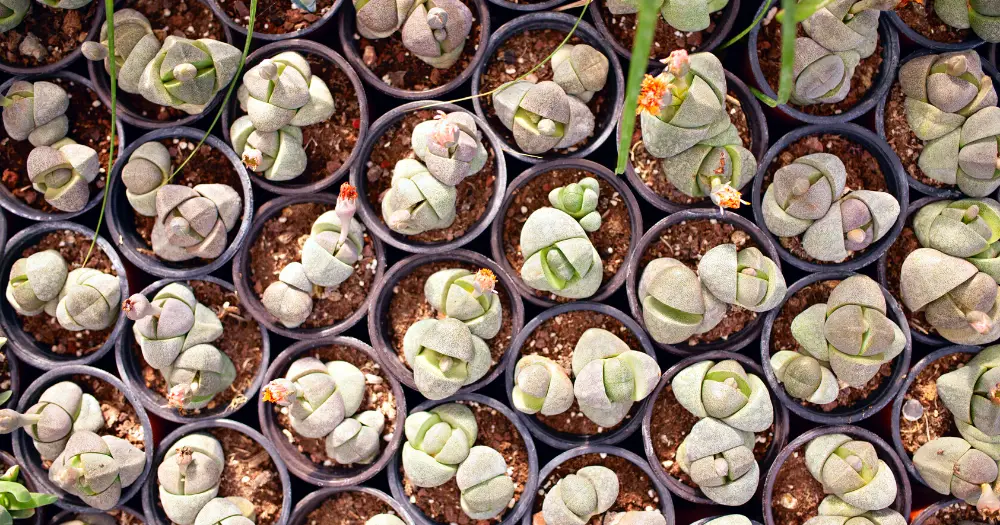
Common Problems & Solutions
Sunburn
Another common problem with ‘Split Rock’ succulents is sunburn, which can cause scarring on the leaves. To prevent this, gradually acclimate the plant to direct sunlight if it has been grown in a shaded area. If sunburn occurs, move the plant to a shadier spot and avoid direct sunlight until the scarring has healed.
You might also like: Sunburnt Succulents
Root Rot
Another issue that may arise with Pleiospilos nelii is root rot, which can occur if the soil is too damp or the plant is overwatered. Signs of root rot in your ‘Split Rock’ include yellowing leaves, soft or mushy stems, and a foul odor. To prevent root rot, ensure that the soil is well-draining and allow it to dry out completely before watering again. If root rot is suspected, remove the affected parts of the plant and repot it in fresh, well-draining soil.
Common Mistakes to Avoid With Pleiospilos nelii
Here are some common mistakes to avoid when growing mesemb succulents like Pleiospilos nelii ‘Split Rock’:
• Planting it with Lithops. Split rock succulents growth cycle is different than Lithops. They split and flower at different times and have different needs at different times of the year. You might also like: Split Rock vs Lithops: Easy Way to Tell Which is Which
• Inadequate light. Split rock succulents need bright light to produce their distinctive leaf shape. Without enough light, the leaves may remain rounded instead of developing splits or clefts. Provide direct sunlight near a sunny window or use a grow light to give your succulent adequate illumination.
• Overwatering. The split leaves of these succulents make them prone to rot if the soil stays soggy. Allow the soil to dry out between waterings and do not leave the pot sitting in water. Check the soil before watering and only water when it is quite dry. It is better to underwater split rock succulents than overwater them.
• Inappropriate temperatures. Most split rock succulents cannot tolerate frost and prefer temperatures of 65 F and up. If your succulent is dropping leaves or showing other signs of stress, it may be due to temperatures that are too low. Move split rock succulents to a warmer spot and protect them from cold drafts. Bring them inside before frost if growing outdoors.
• Inadequate nutrients. Although split rock succulents do not need rich soil, they do require nutrients to support healthy growth. Fertilize during the growing season but reduce or stop feeding in fall and winter when growth slows. Always follow the directions for your fertilizer and do not overfeed, which can damage the succulent.
• Pests or disease. Like all succulents, split rock plants can become infested with common pests or fungal diseases if conditions are right for them to thrive. Check your succulent regularly for any signs of problems and treat them promptly before they spread. Isolating your plant can also help avoid issues spreading to other houseplants.
With proper conditions and care, split rock succulents can thrive and produce their distinctive foliage. Avoiding common mistakes like excess moisture, cold temperatures, and inadequate light will help your succulent grow healthy and strong. A little experience with the needs of split rock succulents will help you keep your plant looking its best.
Is it Poisonous?
‘Split Rock’ is non-toxic and safe to grow around pets and children.
You might also like: Root Rot in Succulents: How to Identify and Treat the Problem
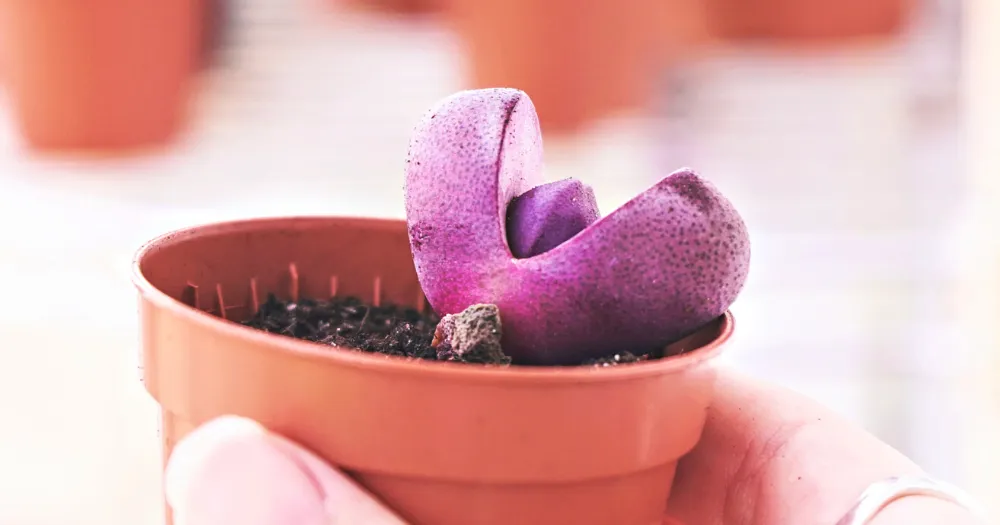
Additional Facts
‘Split Rock’ is a slow-growing plant and can take several years to reach its maximum size of 4 inches in height and 6 inches in width. Its unique appearance makes it an eye-catching addition to any succulent collection.
You might also like: Why You Shouldn’t Plant Succulents in Terrariums: The Risks and Consequences
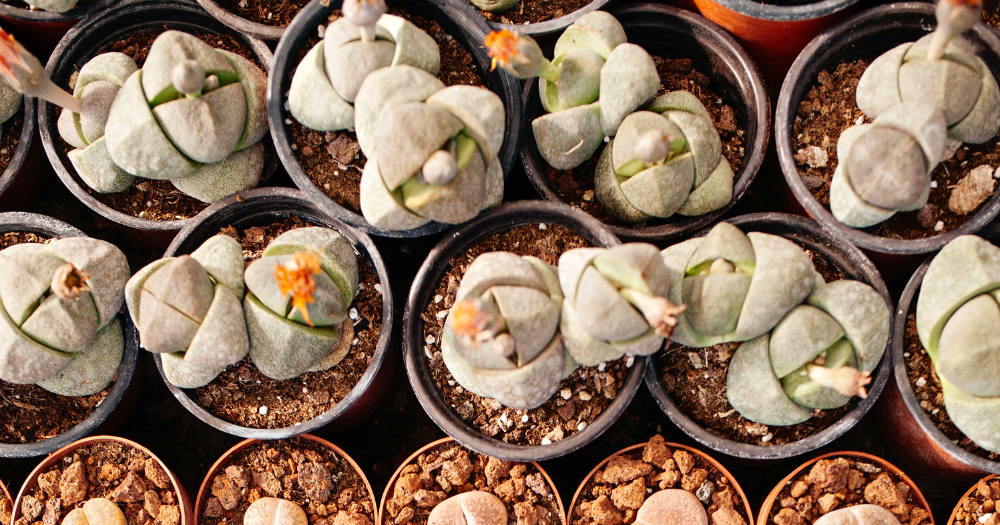
| Common Name | Split Rock Succulent |
|---|---|
| Latin Name | Pleiospilos nelii |
| Native Habitat | South Africa |
| Hardiness Zone | 9-11 |
| Temperature Range | 65-80°F |
| Poisonous? | Non-toxic |

Where to Buy Succulents Online

